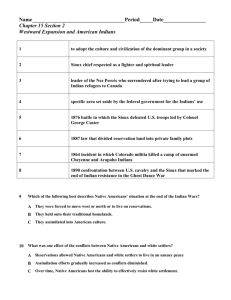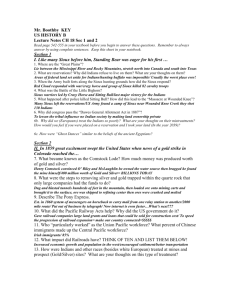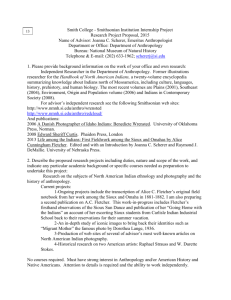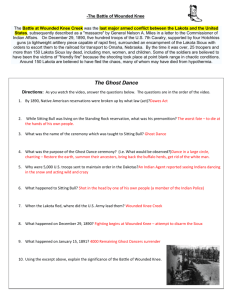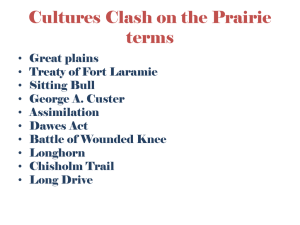Native Americans Powerpoint
advertisement
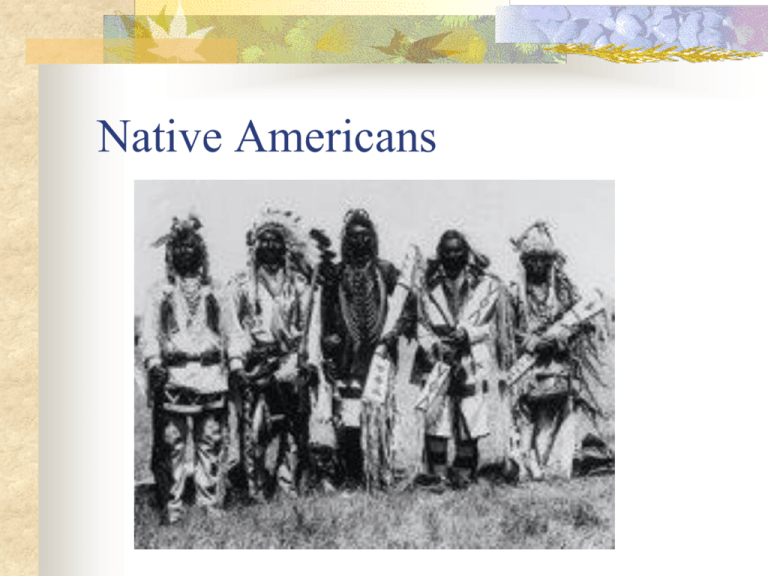
Native Americans Introduction The term, “Native American” applies to a variety refers to dozens of unique societies, each with its own history and cultural heritage Native Americans include Eskimos, Cherokee, Sioux, Mohawk, Incan, Apache, Aleuts, and Zuni to name but a few It is estimated that before European settlers arrived, Native Americans may have numbered as many as 112 million Today about 1.9 million people in America identify themselves as Native Americans... Territory of the Sioux The Plains Indians For centuries the plains were home to several tribes of Native Americans. Most of these were nomads-following herds of buffalo from one hunting ground to the next. Despite some differences, the groups of Plains Indians were similar in many ways. They lived in extended family networks and had a close relationship with nature. The Sioux Uprising In the 19th century, as the railroads hired hunters to exterminate the buffalo herds, the Indians' primary food supply, in order to force all tribes into sedentary habitations, the Dakota and Lakota were forced to accept whitedefined reservations in exchange for the rest of their lands, and domestic cattle and corn in exchange for buffalo, becoming dependent upon annual federal payments guaranteed by treaty. In 1862, after a failed crop the year before and a winter starvation, the federal payment was late to arrive. The local traders would not issue any more credit to the Dakota and the local federal agent told the Dakota that they were free to eat grass. As a result on August 17, 1862, the Sioux Uprising began when a few Dakota men attacked a white farmer, igniting further attacks on white settlements along the Minnesota River. The US Army put the revolt down, then later tried and condemned 303 Dakota for war crimes. President Abraham Lincoln remanded the death sentence of 285 of the warriors, signing off on the execution of 38 Dakota men by hanging on December 29, 1862 in Mankato, Minnesota, the largest mass execution in US history. The Sand Creek Massacre (Nov. 29, 1864) Surprise attack by U.S. troops on a Cheyenne camp. A force of 1,200 men, mostly Colorado volunteers under Col. John M. Chivington, attacked several hundred Cheyenne camped on Sand Creek near Fort Lyon in southeastern Colorado Territory. The Indians had been conducting peace negotiations with the fort's commander; when the attack began, they raised a white flag, but the troops continued to attack,massacring more than 200 of them. The slayings led to the Plains Indian wars. Battle at the Little Bighorn The Laramie Agreement In late 1875, Sioux and Cheyenne Indians were angered at the whites travelling into their sacred lands in the Black Hills. Gold had seen many miners entering the sacred land Promises Broken The US Government had promised Red Cloud that white settlers would not be allowed to settle here. This was part of the Fort Laramie Treaty. The Sioux gathered with Sitting Bull to fight for their lands. CUSTER To force the large Indian army back to the reservations, the Army sent Lt. Colonel George Custer and the Seventh Cavalry. Spotting the Sioux village about fifteen miles away along the Rosebud River on June 25, Custer also found a nearby group of about forty warriors. Out Numbered Ignoring orders to wait, he decided to attack before they could alert the main party. He did not realize that the number of warriors in the village numbered three times his strength. Crazy Horse Cheyenne and Hunkpapa Sioux together crossed the river and slammed into the advancing soldiers, forcing them back Meanwhile, another force, largely Oglala Sioux under Crazy Horse's command, surrounded Custer and his men in a pincer move. They began pouring in gunfire and arrows. Last Stand As the Indians closed in, Custer ordered his men to shoot their horses and stack the carcasses to form a wall, but they provided little protection against bullets. In less than an hour, Custer and his men were killed in the worst American military disaster ever. REVENGE Little Bighorn showed the Indians' power. They had achieved their greatest victory Outraged over the death of a popular Civil War leader the US Government fought back The Massacre at Wounded Knee Fall of the Lakota Sioux The Lakota Sioux Indians were nomadic plains dwellers who followed herds of Buffalo By the year 1860, the American government had built roads and forts on the Sioux land In 1877-1879 the Sioux Indians were subjugated by the U.S. government By 1890 the Sioux Indians found their previous life destroyed, the Buffalo gone, themselves cramped in minute reservations The Ghost Dance In 1888 an Indian holy man called Wovaka began the Ghost Dance Religion The Ghost Dance touched upon elements of traditional Native American culture and Christianity It foretold of freedom for all Indians from white domination Members of the Ghost Dance movement included Chiefs Sitting Bull and Big Foot The Ghost Dance During the fall of 1890, the Ghost Dance spread to the Sioux villages in the Dakota reservations Members of the Ghost Dance wore shirts emblazoned with eagles, which they believed could deflect bullets White officials became alarmed and in December banned the practice of the Ghost dance on Lakota reservations The death of Sitting Bull The order was sent out to capture Chief Sitting Bull, one of the leaders of the Ghost Dance Sitting Bull attempted to seek sanctuary in the South Before he could leave Standing Rock Reservation, an attempt was made to arrest Sitting Bull on December 15th Sitting Bull and 7 of his warriors, as well as 6 policeman, were killed in the ensuing scuffle The flight of Big Foot When he heard the news of Sitting Bull’s death, Chief Big Foot rallied his followers and attempted to flee to the protection of Chief Red cloud Sitting Bull fell ill from pneumonia during the trip, and was forced to ride in the back of a wagon A detachment of the 7th U.S. Cavalry under Major Samuel Whitside were tasked with intercepting Chief Big Foot Capture On December 28th, the 4 troops of cavalry intercepted the Indians, who surrendered Major Whitside almost attempted to disarm the Indians on the spot, but was dissuaded by one of his staff In a moment of compassion, Whitside ordered a field ambulance to transport Big Foot The Indians were escorted to a temporary camp on the banks of Wounded Knee Creek Wounded Knee camp When the Indians reached the camp at dusk, they were counted and given rations and shelter In total the Indians numbered about 120 men, and 230 women and children To ensure the Indians did not escape, Whitside placed two Hotchkiss guns on a ridge overlooking the Indian lodges During the night, more cavalry and Hotchkiss guns arrived under Colonel Forsyth who assumed command, bringing the number of soldiers up to 500 Disarming the Indians The next day, Colonel Forsythe called all the Indian men to the center of the camp Informing the Indians that they were to be disarmed, he ordered them to surrender their weapons The Colonel ordered the camp searched for hidden weapons, but he only found two rifles When attempting to take a rifle from a deaf Indian, Black Coyote, The soldiers accidentally discharged the weapon The Massacre begins… The cavalrymen immediately opened fire with their carbines Most of the casualties were in the first 10-20 minutes of fighting The Indians then attempted to attack the soldiers at close quarters Few of the Indians had weapons, and soon they had to flee The Hotchkiss guns opened fire, systematically destroying the Indian encampment Aftermath When the slaughter had ended, Chief Big Foot and 153 of his tribesman lay dead in the snow, many more died of their wounds About 300 of the original 350 Indians had died as a result of the massacre The 7th Cavalry suffered 25 dead and 37 wounded, mostly caused by ‘friendly fire’ The surviving Indians were rounded up, spending the freezing night in a Church Conclusion Black Elk-one of the survivors of Wounded Knee “I did not know then how much was ended. When I look back now from this high hill of my old age, I can still see the butchered women and children lying heaped and scattered all along the crooked gulch as plain as when I saw them with eyes still young. And I can see that something else died there in the bloody mud, and was buried in the blizzard. A people's dream died there. It was a beautiful dream . . . . the nation's hoop is broken and scattered. There is no center any longer, and the sacred tree is dead” ---- Black Elk
